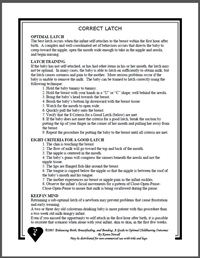Breastfeeding Latch
Get Started with The Proper Latch from the 1st Day The correct breastfeeding latch is important to establish from the first day. A free download on the 8 Criteria of a proper latch is at the bottom of this web page. 
Download of the Latch Brochure At the Bottom of this Page Getting Started with the Correct Breastfeeding Latch Getting the baby started with a good latch is crucial. It ensures that the baby is able to extract the milk from the breast, ensuring adequate nutrition and growth. It also prevents the common problems of engorgement and sore nipples.
If any of these problems do occur, correcting the latch is essential to solve the problem and reverse the unwanted side effects. The best latch occurs when an infant self-attaches skin to skin with the mother in the first few hours of life. Here, the infant is not manipulated by procedures that must be accomplished within set time frames, but is left on the mother’s abdomen and crawls to the breast when he or she is ready to eat. The infant’s head bobs as she finds the perfect placement, and her mouth opens to its widest. Once the infant achieves a successful latch, she relaxes the rest of her body and enjoys the new sensation of suckling.
While self-attachment in the first hour might be the ideal, most infants born in hospitals do not have that experience, and instead need to overcome breastfeeding obstacles they have encountered prior to being latched on. The article on delayed attachment describes how an infant who did not have the opportunity to self-attach in the first few hours can still do so in the first weeks of life.
It is valuable to realize that latching on is not difficult. In fact, any baby can do it. What is difficult is overcoming a poor or insufficient latch. Latch Training If the baby has not self-attached, or has had other items in his or her mouth before the breast, the breastfeeding latch may not be optimal. In many cases, the baby is able to latch on sufficiently to obtain milk, but the latch causes soreness and pain to the mother.
More serious problems occur if the baby is unable to remove the milk. The baby can be trained to latch correctly using the following technique: - 1. Hold the baby tummy to tummy.
- 2. Hold the breast with your hands in a “U” or “C” shape, well behind the areola.
- 3. Bring the baby’s head towards the breast.
- 4. Brush the baby’s bottom lip downward with the breast tissue.
- 5. Watch for the mouth to open wide.
- 6. Quickly pull the baby onto the breast.
- 7. Verify that the 7 Criteria for a Good Latch (below) are met.
- 8. If the baby does not meet the criteria for a good latch, break the suction by putting the tip of your finger in the corner of her mouth and pulling her away from the breast.
- 9. Repeat the procedure for putting the baby to the breast until all criteria are met.
8 Criteria of the Correct Breastfeeding Latch How do you know if a baby has latched-on to the breast correctly? Here are eight criteria to watch for: - 1. The chin is touching the breast.
- 2. The flow of milk will go toward the top and back of the mouth.
- 3. The nipple is centered in the mouth.
- 4. The baby’s gums will compress the sinuses beneath the areola and not the nipple tissue.
- 5. The lips are flanged fish-like around the breast.
- 6. The tongue is cupped below the nipple so that the nipple is between the roof of the baby’s mouth and his tongue.
- 7. The mother experiences no breast or nipple pain as the infant suckles.
- 8. Observe the infant’s facial movements for a pattern of Close-Open-Pause- Close-Open-Pause to insure that milk is being swallowed during the pause.
Breastfeeding Latch Reminders Retraining a sub-optimal latch of a newborn may prevent problems that cause frustration and early weaning.
A two or three day old colostrum-drinking baby is more patient with this procedure than a two week old milk-hungry infant. Therefore, you want to correct problems with the breastfeeding latch early.
Even if you missed the opportunity to self attach in the first hour after birth, it is possible to recreate that scenario when alone with your infant, skin to skin, in the first few weeks.
See more information on mother's hand position while latching-on for offering the breast to the baby.
Older Babies If your baby is more than a few days old and not latching properly, you may need to retrain baby for the proper latch. Read our four tips for retraining. Download our Brochure on Correct Breastfeeding Latch  Our brochure Correct Breastfeeding Latch lists 8 criteria of the correct latch and instructions to ensure a proper latch. Print the brochure and keep it with you in your labor bag. You just may need it! Another window will open to allow you to print the brochure. Return from Breastfeeding Latch to the Better Childbirth Outcomes HOME PAGE.
| 
